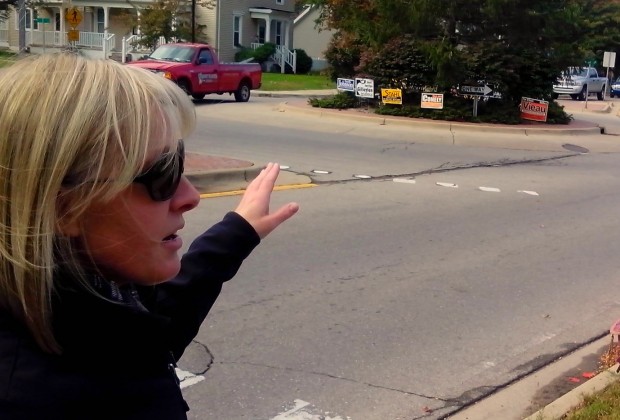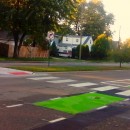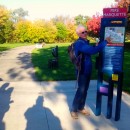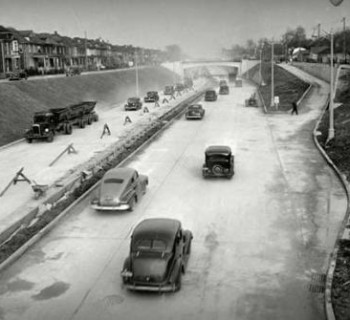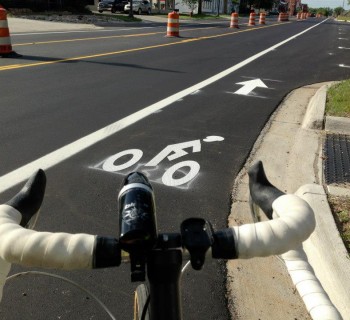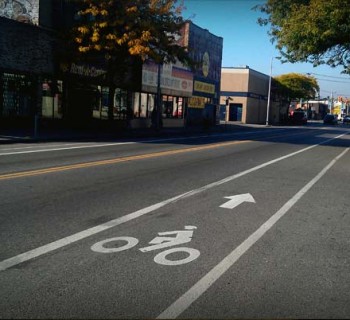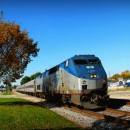If you've ever found yourself cruising around a giant paved donut while driving, you're no doubt familiar with roundabouts.
For those who aren’t, a roundabout is a circular intersection where vehicles travel in one direction around a central traffic island. Anyone who’s traveled one where motorists aren’t following the rules understands it’s a subject that can get folks’ blood boiling.
Created as an improvement over early traffic circles, modern roundabouts first emerged in England in the 1960s. They're now fairly commonplace in Europe, but have been slower to catch on in the United States. The circular intersections didn’t really start appearing in force on U.S. roads until the 1990s; about 3,700 now exist here.
As road elements go, the vehicular merry-go-rounds are quite contentious. People tend to praise or revile them. Anna Kohn, director of Detroit's downtown synagogue, tells Mode Shift she isn’t a fan.
"Honestly, getting on a roundabout for the first time in my life, I felt like I was back in driver's education,” she says. “Massachusetts (especially Western Mass where I went to school) had no shortage of roundabouts -- and I definitely feared for my life each time I'd try to enter one. I'm used to simple things, like four-way intersections and Michigan lefts, not a circular free-for-all of honking and being cut off."
She's not the only one with a ring-shaped chip on her shoulder. Karen Potter, a city council woman in Perry, Mich. set up an online petition on Change.org to stop one from being built in her Shiawassee County hometown.
"This roundabout will hurt our local business and create a huge traffic nightmare for locals," she wrote. "Many truckers who use I-69 daily have already said if that goes in they will pass the Perry exit all together.”
It should be noted that many roundabout islands feature a concrete lip, or “apron,” that discourages most motorists from riding over it but gives semi-trucks and emergency vehicles more leeway to navigate turns.
MDOT withdrew plans for that Perry project last May, according to Potter's facebook page.
The circular intersections also have their defenders. Detroiter Joey Aasim, who works at a local bike space, was enthusiastic to talk about them.
In his view, installing roundabouts would help resolve traffic snarls at two busy Detroit crossroads: the intersection of Broadway and Gratiot and the three-way at Grand River, Trumbull and Martin Luther King, Jr. Boulevard.
In terms of flow, he appreciates how they calm traffic, instead of simply bringing it to a stop. As an avid cyclist, Aasim also likes how roundabouts give bicyclists and pedestrians a place to pause at intersections.
In fact, Aasim often prefers them to stop lights at complex intersections.
"Lights are above the horizon, when really we need to be looking at road level, and roundabouts facilitate both safety and efficiency," he says.
Roundabouts have an edge over other types of intersections when it comes to safety.
They reduce fatalities more than 90 percent, injuries by 70 percent and crashes by 35 percent, according to the Federal Highway Administration (FHWA).
Slower speeds in and around the intersection and fewer points of contact are typically safer for people traveling on foot. The agency’s website also notes that the splitter island refuge area allows pedestrians who don’t have visual impairments to focus on a single stream of traffic while crossing the road.
Andrew Langenderfer is a Senior Project Manager for Tetra Tech, a firm that’s built 20 roundabouts over the last five years. He says while traffic signals may be a better solution at excessively high volume intersections, and four-way stops may be “sufficient” to handle very low-volume crossways, that roundabouts have been “highly effective” at improving safety and efficiency at certain intersections.
Hanna Pritchard, a civil engineer with the Toole Design Group, tweeted Mode Shift to stress the importance of building them right. “The most important thing about roundabouts is that they be designed correctly for the vehicles, bike, peds expected,” she said. “Poorly designed roundabouts are the WORST PR for good roundabouts.”
It’s also important to remember that education, enforcement and encouragement should accompany the infrastructure itself to ensure people understand and respect their proper use.
As of 2013, Michigan had 109 roundabouts, most in county or municipal road systems, according to the Michigan Department of Transportation. MDOT has built 25 on the state highway system and has nine more in the works.
Spokesman James Lake says the agency has had “very positive results” with roundabouts improving traffic flow and safety at intersections. There’s been a decline in overall crashes and each of their roundabouts has seen the severity of crashes decrease.
"Even in locations where the number of crashes has increased,” Lake says, “they are usually ‘fender-bender’ type crashes, rather than the severe angle or ‘T-bone’ crashes at other types of intersections...Drivers spend less time idling at intersections, saving fuel and emissions, and congestion is reduced."
It’s common for drivers to object when MDOT announces plans to build a roundabout, especially those unfamiliar with modern roundabouts, who may worry about traffic back-ups and crashes involving inexperienced drivers. As time passes, Lake says, the opposition usually dissipates.
“After roundabouts are complete, and their benefits become apparent, we start to hear many more compliments, and the complaints go away,” he says, “As roundabouts become more common in Michigan, there seems to be better initial acceptance of new installations.”


